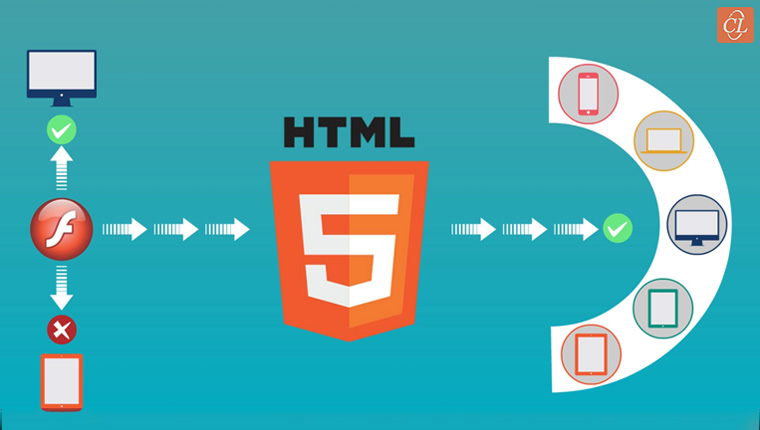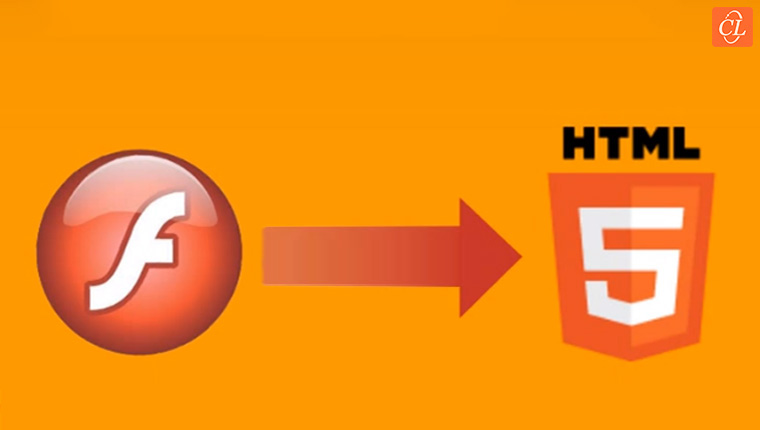5 Challenges to Overcome When Converting Flash to HTML5 eLearning

Flash to HTML5 conversion is the only option to salvage your existing eLearning courses. We all know why. Flash will cease to exist by 2020 and your online training will come to a standstill if Flash courses with current, relevant content are not converted to HTML5. While the end is certain, the challenges you might face during the Flash to HTML5 conversion process can be endless.
5 Challenges to Overcome When Converting Flash to HTML5 eLearning
- Identifying relevant courses for conversion and deciding the strategy
- Getting top management approval for outsourcing
- Choosing an authoring tool for all conversion requirements
- Managing the conversion process within time and budget
- Setting up quality checks
Considering the quantum of work will differ for various existing courses, the migration process isn’t going to be a cakewalk. However, better preparation can make all the difference. So, what are the some of the challenges you have to overcome when converting Flash to HTML5 eLearning? This blog lists five challenges along with their solutions.
Converting Flash to HTML5 eLearning: 5 Challenges and Their Solutions
1. Identifying Relevant Flash Courses for Conversion and Deciding the Strategy
Running an audit of your existing eLearning repository can be a cumbersome task. However, you can’t miss this step since it will help you identify and gather Flash-based eLearning courses that are still relevant and need to be converted. Begin by gathering courses developed in Flash as well as those with Flash elements such as video tutorials and audio resources that require the Flash player to run.
Look for extensions such as .swf and .flv to identify them. Once done, you can move on to organizing these resources. Although there can be multiple ways to segregate and organize Flash-based courses, you can do it this way:
- Courses without source files
- Courses developed in older versions of authoring tool
- Courses developed in software now obsolete
- Courses that need complete design overhaul
Now it’s time to decide how each type of courses should be converted, i.e., the Flash to HTML5 conversion strategy. We have the 4 ‘R’s mantra to help you beat this challenge.
For option 2, you can go with the Republish conversion methodology where existing courses are converted with a newer version of the same authoring tool. Opting for the Redesign conversion methodology makes sense in case 4. It involves a complete makeover of Flash courses including technology, look-and-feel, and new-age strategies such as microlearning.
Options 1 and 3 might seem tricky. How do you convert these Flash-based courses to HTML5?
- In case you don’t have source files (option 1), you can go with the Record conversion strategy. Existing courses are played and recorded using screen recording software. The output is saved in the MP4 format which is HTML5-compatible. However, recording will only make sense if there are no significant interactions and the difficulty of learning is low.
- For existing courses developed using software such as Flash (which are now obsolete), you can opt for the Rebuild conversion methodology. This strategy involves redeveloping existing courses using a new authoring tool for HTML5 output.
2. Getting Top Management Approval For Outsourcing
Apart from the perpetual challenges of shrinking training budgets and fewer resources, you also have to get the buy-in from top management if you want to outsource Flash to HTML5 conversion. Outsourcing to an eLearning vendor is a smart move when you don’t have the necessary resources and expertise in-house.
This implies your business case has to justify the investment in outsourcing Flash to HTML5 including the need, benefits, timeline, savings that will accrue, industry data to support this move, and more.
Here are some points that will help you make the case for outsourcing Flash to HTML5 stronger.
If you have many courses to convert from Flash to HTML5 and your internal team is hard-pressed for time, mention how outsourcing it to an expert eLearning vendor will help in making things faster. Moreover, you save time and effort on mechanical tasks such as tracking the courses being converted, managing the sudden change in resource availability, testing courses before the final launch, and so on. To put it simply, the onus of completing the project within time and budget shifts to the eLearning vendor’s project management team.
If outsourcing the entire process of Flash to HTML5 conversion isn’t going to get you approval, think of outsourcing parts where your in-house team lacks the expertise. For instance, if your internal team can Record but not Rebuild, you can outsource this conversion need to an eLearning vendor who has the required expertise in authoring tools.
This helps you save the cost of buying authoring tools and software in addition to making the process faster since they are well-versed with resolving issues and will have resources to absorb the additional workload in case of scaling up.
3. Choosing an Authoring Tool for All Conversion Requirements
Since your organization will have different conversion needs, you need to select an authoring tool that caters to all of them. This can be quite challenging, considering there is an array of authoring tools available in the market. Begin by deciding if you want the final output to be fully responsive or mobile-friendly.
Most popular authoring tools such as Storyline 360, Trivantis Lectora, and Adobe Captivate offer common features including screen recording, in-built asset library, and responsive output that make them the ideal choice for Flash to HTML5 conversion. However, you have to choose the one which matches your conversion requirements the most. Here are some features of popular eLearning authoring tools to help you decide better.
If the majority of your Flash courses are text-heavy and you are looking for a completely responsive output, you can go with Trivantis Lectora for Flash to HTML5 It offers on-screen scroll to accommodate heavy content without moving to the next slide. Moreover, Trivantis offers a complete cloud authoring solution if you opt for Lectora Online. It offers the features of the desktop-application with the freedom of collaboration over the web.
Adobe Captivate is another popular choice for Flash to HTML5 conversion. It offers features for all the 4 ‘R’s conversion strategies. For instance, screen capture feature for Record, save as responsive project for Republish, Fluid box and interactivities for Rebuild, and a library of assets for Redesign.
If your existing eLearning courses contain substantial Flash interactivities, opting for Storyline 360 for the conversions makes sense. Even if the Flash interactivities cannot be converted directly, Storyline offers the best possible alternatives.
4. Managing the Conversion Process Within Time and Budget
Being a training manager, you have to ensure your training is delivered on time and within the designated budget. And this is possible only if the Flash to HTML5 conversion process goes without any roadblocks. It heavily relies on how the process is managed. In case of outsourcing, you have to closely work with the vendor’s project manager to ensure the process is on track.
Here are some tips for successfully managing the Flash to HTML5 conversion process:
- Handover all existing courses, source files, and supporting media elements to the eLearning vendor for them to begin on time. Ensure course conversions are prioritized. For instance, courses that are important and required for immediate use should be converted first.
- Collaborate with the project management team to freeze on the project milestones and timelines. In case of outsourcing overseas, time zone differences should be kept in mind. This helps in planning the conversion accordingly. For instance, if your in-house team reviews a course during your day, the overseas eLearning vendor can implement changes during their day, which will be your night.
- Break the conversion project into logical batches to ensure budget is adhered to. This also enables faster development and ensures similar mistakes are not repeated in the subsequent batches.
- Ensure there is a risk management process in place for resolving ambiguities faster. These could be functionality errors in the converted courses, sudden unavailability of team members, and so on.
- Get the existing content updated (if needed) by your SMEs well in advance. The vendor’s team can start with the conversions right away.
- Make use of online review solutions such as Lectora ReviewLink to make the review and feedback cycle faster. Reviewers can access a course online via a link, write in-context feedback, resolve ambiguous ones, and send coherent feedback – all in one place.
5. Setting up Quality Checks
Working on tight deadlines can often lead to a compromise on the quality of the output. Your role is imperative in ensuring this crucial factor of successful Flash to HTML5 conversion is adhered to. So, how do you manage quality output?
Here are some tips:
- Formulate a branding and style guide. This helps in maintaining consistency throughout the converted courses and ensuring each course is on par with the quality standards.
- Form an internal review team. It can consist of SMEs and various stakeholders such as reviewers, functional heads, and quality analysts. Assign them their responsibilities to ensure error-free courses. For instance, SMEs should ensure content accuracy, reviewers can collect and resolve conflicting feedback
- Ensure the eLearning vendor has set quality assurance process in place. This includes adhering to checklists, branding guidelines, updating logs when new issues arise, and so on.
- Use the preview option available in most eLearning authoring tools. It shows how the course will look in various devices and orientation.
- Ensure your converted Flash to HTML5 courses are tested on mobile devices for functionality. This includes testing the buttons, interactivities, and so on.
It’s Wrap Time
While these are a few common challenges you might come across, the list isn’t limited. The secret is to have a plan in place for all possible ambiguities, without hindering time, cost, and quality. If your conversion needs are large and you don’t have enough in-house resources to fulfill the target, it’s better to outsource. The vendor can lend their expertise in successfully completing the Flash to HTML5 conversion process.
Did I forget to mention the free eBook on Flash to HTML5 eLearning conversion? Well, here it is. Download “Flash to HTML5 eLearning Conversion: The 4 ‘R’s That Matter,” to know everything you need to get started with the migration process. Happy Reading!




![Flash to HTML5 Conversion: Problems and Solutions [SlideShare]](https://blog.commlabindia.com/hubfs/Imported_Blog_Media/flash-html5-conversion-problems-solutions-slideshare.jpg)
